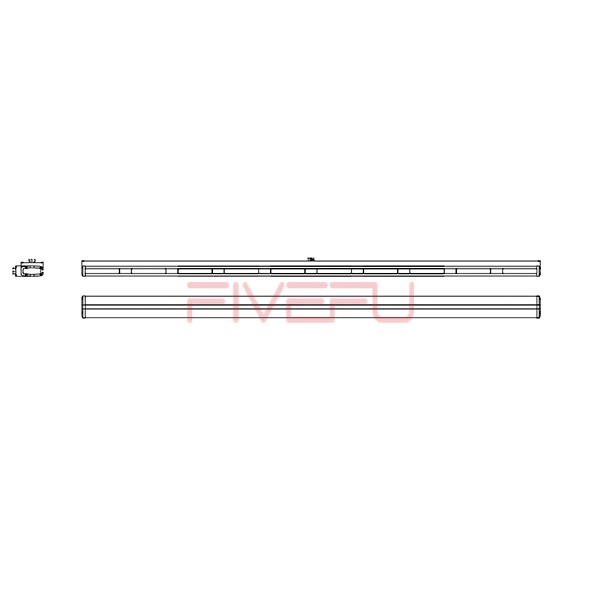LED sticks, or LED strip lights, come in various types, each offering distinct features and functionalities suited to different applications. These versatile lighting solutions can be used for aesthetic enhancements, mood lighting, task lighting, and much more. Here’s an overview of the primary types of LED sticks you might encounter, reflecting the diversity and adaptability of LED technology:

- Single-Color LED Strips
Description: Emit a single color of light and are available in a wide range of colors, including warm white, cool white, and amber.
Applications: Ideal for creating uniform, ambient lighting in spaces where a specific color mood is desired, such as under car chassis for subtle effects or in interior design projects.
- RGB LED Strips
Description: Contain red, green, and blue LEDs that can be mixed to produce a broad spectrum of colors, controlled via a remote or a controller.
Applications: Perfect for dynamic lighting setups where color changes are desired, such as in entertainment areas, vehicle customization, or for mood lighting that can be adjusted to the occasion.
- RGBW LED Strips
Description: Add an extra white chip to the RGB setup, allowing for purer whites and a wider color range, providing more nuanced color mixing capabilities.
Applications: Suitable for applications requiring both colorful RGB effects and high-quality white light for tasks or ambiance, offering greater flexibility in lighting design.
- Tunable White LED Strips
Description: Allow for adjusting the color temperature of white light from warm to cool, enabling the user to set the mood or match the natural light during the day.
Applications: Ideal for environments where the light needs to adjust to specific tasks, time of day, or to complement natural lighting, such as in homes, offices, or studios.
- Waterproof LED Strips
Description: Coated with a waterproof material, these strips are suitable for outdoor use or in areas where they might come into contact with moisture.
Applications: Great for outdoor lighting, around pools, in kitchens, bathrooms, or any place where water resistance is a necessity.
- Smart LED Strips
Description: Can be controlled via smartphone apps, voice commands, or integrated into smart home systems, offering extensive customization and scheduling options.
Applications: Best for tech-savvy users looking to integrate lighting with smart home technology, allowing for automated and responsive lighting environments.
- High CRI LED Strips
Description: Feature a high color rendering index (CRI), which means they represent colors more accurately and vividly, similar to natural light.
Applications: Particularly useful in settings where accurate color representation is crucial, such as in art studios, galleries, or retail displays.
- Addressable LED Strips
Description: Each LED (or group of LEDs) can be controlled individually, allowing for complex patterns, animations, and effects.
Applications: Ideal for custom lighting projects, signage, and where individual control over the lighting effects is desired, offering unparalleled creativity in lighting design.
When selecting LED sticks for your project, consider the intended application, desired effects, and environmental conditions. Whether for vehicle customization, home décor, or professional settings, there’s an LED stick type tailored to meet the specific needs of your project, combining efficiency, versatility, and creativity.
What are the benefits of LED strip emergency lights?
LED emergency lights are a crucial component in ensuring safety and visibility in critical situations. With advancements in LED technology, these lights have become the preferred choice for emergency vehicles, exit signs, and safety equipment. Here are the key benefits that LED emergency lights offer:
- Enhanced Visibility
LEDs produce a bright, intense light that is instantly recognizable, which is vital for emergency vehicles needing to be seen from great distances or in poor visibility conditions.
- Energy Efficiency
LED lights consume significantly less power compared to traditional incandescent or halogen bulbs. This efficiency reduces the load on the vehicle’s electrical system, allowing emergency vehicles to operate additional equipment without worrying about draining the battery.
- Durability and Reliability
LEDs are solid-state lights, meaning they are more resistant to shock, vibration, and wear compared to filament-based bulbs. This durability is crucial in emergency situations, where reliability can make the difference in operational effectiveness.
- Longevity
LED lights have a much longer lifespan, often exceeding 50,000 hours of use. This longevity reduces the need for frequent replacements, ensuring that emergency lights are always operational when needed.
- Low Heat Emission
Unlike incandescent bulbs, which can get extremely hot, LEDs emit very little heat. This characteristic minimizes the risk of burns during operation or maintenance and reduces the heat load on the vehicle’s interior.
- Instant On
LED lights reach full brightness immediately, without the warm-up time required by some other types of lights. This feature is critical in emergency situations where immediate visibility is necessary.
- Versatility and Compact Size
The small size of LED components allows for more compact and flexible lighting designs. This versatility enables the creation of various light patterns and intensities, tailored to specific requirements of different emergency vehicles and situations.
- Cost-Effectiveness
While the initial investment in LED emergency lights may be higher than traditional lighting, their long lifespan, reduced maintenance needs, and energy efficiency offer significant cost savings over time.
- Improved Safety
The ability to produce directional light allows LED emergency lights to focus brightness where it’s most needed, improving safety for emergency responders and the public.
- Environmentally Friendly
LEDs are more environmentally friendly than traditional bulbs, containing no hazardous materials like mercury, which is found in some other types of lights. Additionally, their energy efficiency and longevity contribute to lower energy consumption and waste.









